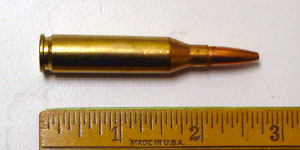.243 Win
| .243 Winchester | ||||||||||||||||||||||||
|---|---|---|---|---|---|---|---|---|---|---|---|---|---|---|---|---|---|---|---|---|---|---|---|---|

.243 Winchester cartridge
|
||||||||||||||||||||||||
| Type | Rifle | |||||||||||||||||||||||
| Place of origin | USA | |||||||||||||||||||||||
| Production history | ||||||||||||||||||||||||
| Designer | Winchester | |||||||||||||||||||||||
| Manufacturer | Winchester | |||||||||||||||||||||||
| Produced | 1955 | |||||||||||||||||||||||
| Variants | .243 Winchester Improved (Ackley) | |||||||||||||||||||||||
| Specifications | ||||||||||||||||||||||||
| Parent case | .308 Winchester | |||||||||||||||||||||||
| Bullet diameter | .243 in (6.2 mm) | |||||||||||||||||||||||
| Neck diameter | .276 in (7.0 mm) | |||||||||||||||||||||||
| Shoulder diameter | .454 in (11.5 mm) | |||||||||||||||||||||||
| Base diameter | .471 in (12.0 mm) | |||||||||||||||||||||||
| Rim diameter | .473 in (12.0 mm) | |||||||||||||||||||||||
| Case length | 2.045 in (51.9 mm) | |||||||||||||||||||||||
| Overall length | 2.7098 in (68.83 mm) | |||||||||||||||||||||||
| Case capacity | 52 or 53 to 54.8gr H2O | |||||||||||||||||||||||
| Rifling twist | 1-10 to 1-8 | |||||||||||||||||||||||
| Primer type | Large Rifle | |||||||||||||||||||||||
| Maximum pressure (SAAMI) | 60,000 psi (410 MPa) | |||||||||||||||||||||||
| Ballistic performance | ||||||||||||||||||||||||
|
||||||||||||||||||||||||
|
Test barrel length: 24" Source(s): Hodgdon http://data.hodgdon.com/cartridge_load.asp |
||||||||||||||||||||||||
The .243 Winchester (6×52mm) is a popular sporting rifle cartridge. Initially designed as a target/varmint round, it may be used for animals such as coyote, blacktail deer, whitetail deer, mule deer, pronghorn, and wild hogs. It can also be used against larger animals such as black bear or elk but is sometimes said to be "too light" for such large animals. Rounds of at least 90 grains are better suited for hunting larger animals while rounds less than 90 grains are more suitable for varmints. The .243 is based on a necked down .308 cartridge case. It is very popular with target shooters, Metallic Silhouette, and long range shooters, because of its accuracy and low recoil.
This cartridge was first introduced in 1955 for the Winchester Model 70 bolt-action and Model 88 lever-action sporting rifles and quickly gained popularity among sportsmen worldwide. Just about every major manufacturer offers rifles chambered in .243.
It was a ground-breaking development of the day, combining a very useful combination of lightweight (70 to 85 grain) bullets optimized for long-range performance for varmint hunters (groundhogs, coyotes, prairie dogs) and 90 to 105-grain bullets suitable for the game up to the size of deer and pronghorn antelope. Its predecessor in the Winchester lineup, the very similar .257 Roberts, could have easily been selected to accomplish the same tasks, but was not available factory loaded with either lighter, varmint-weight bullets or pointed, long range spitzer (pointed) bullets, so it never achieved the popularity of the newer round.
Remington also saw the 6mm (.243") family as suitable for this dual-purpose use and introduced their version, the .244 Remington, in the same year (1955) based upon the .257 Roberts necked down to accept .243 bullets up to 90 grains in weight. The Winchester round remains available today whereas the .244 Remington, later renamed the 6mm Remington with the introduction of 100-grain bullets, is far less popular even though it can push all bullet weights slightly faster with maximum loads due to the larger capacity case. The fact that the .243 Win was originally offered in a 1 in 10" rifling twist rate, a rate better able to stabilize heavier 100 and 105-grain bullets, versus the .244 Remington's 1 in 12" twist (hence the 90-grain factory offering) was also a factor in their popularity.
...
Wikipedia
